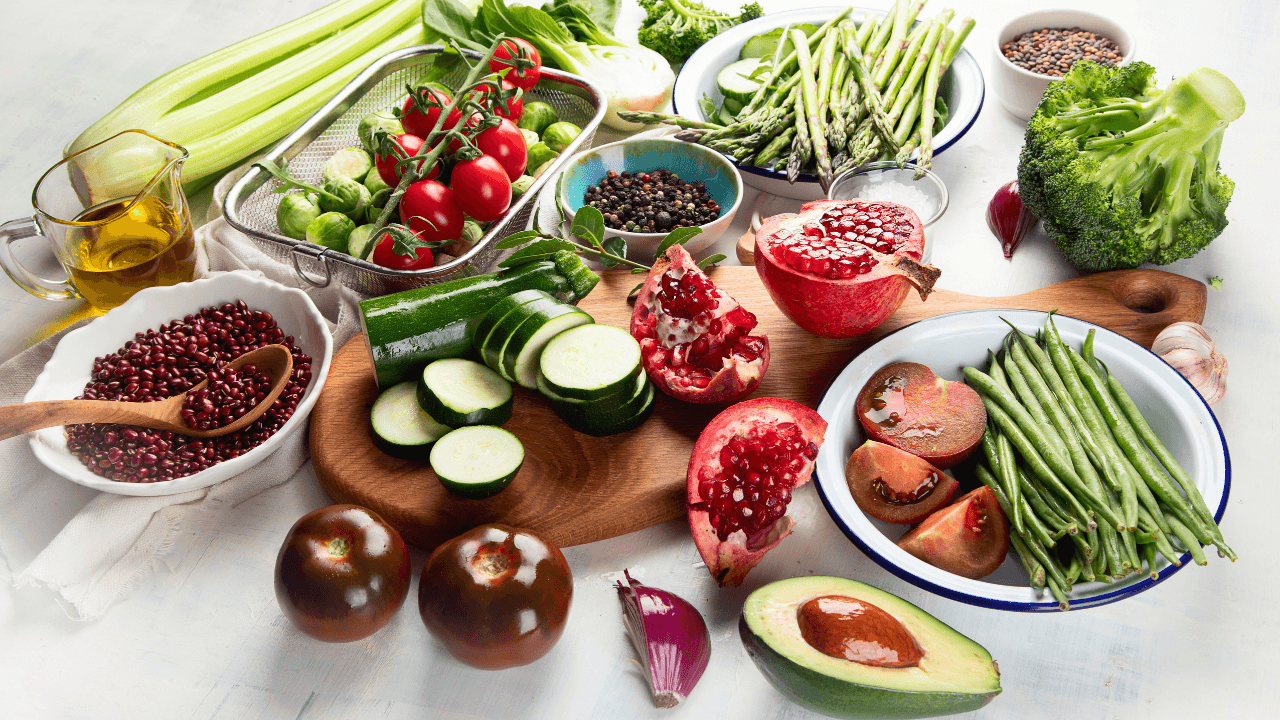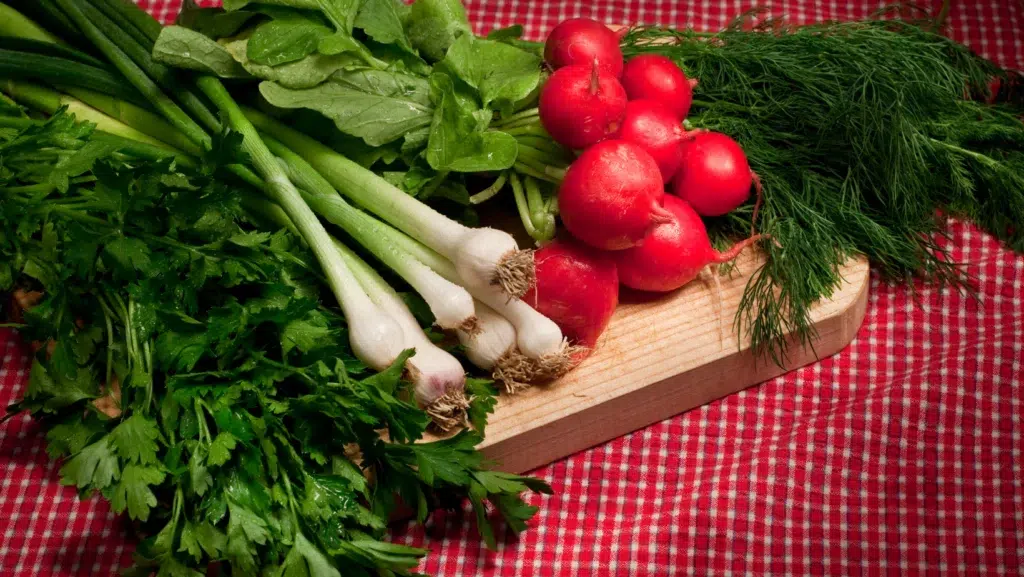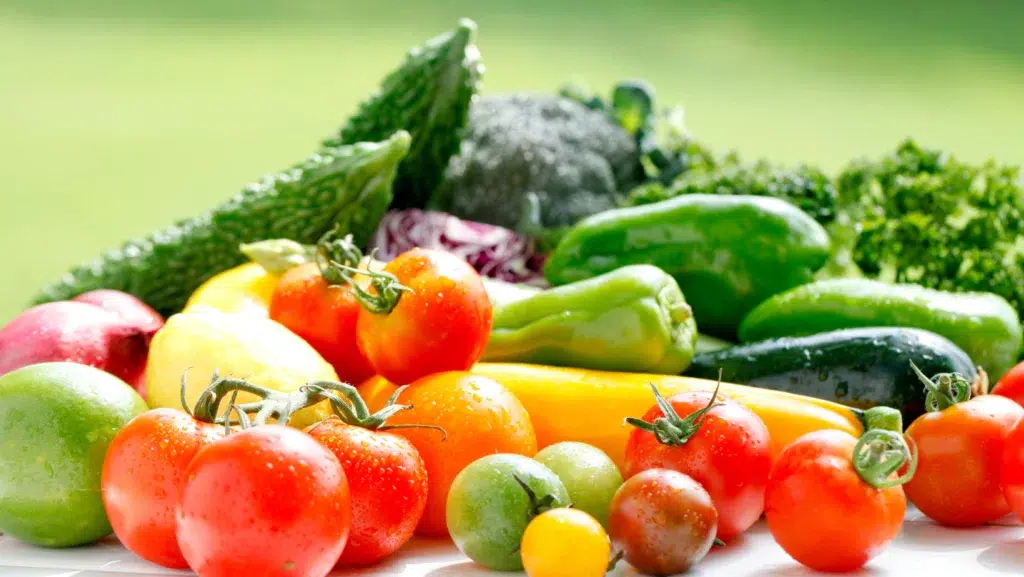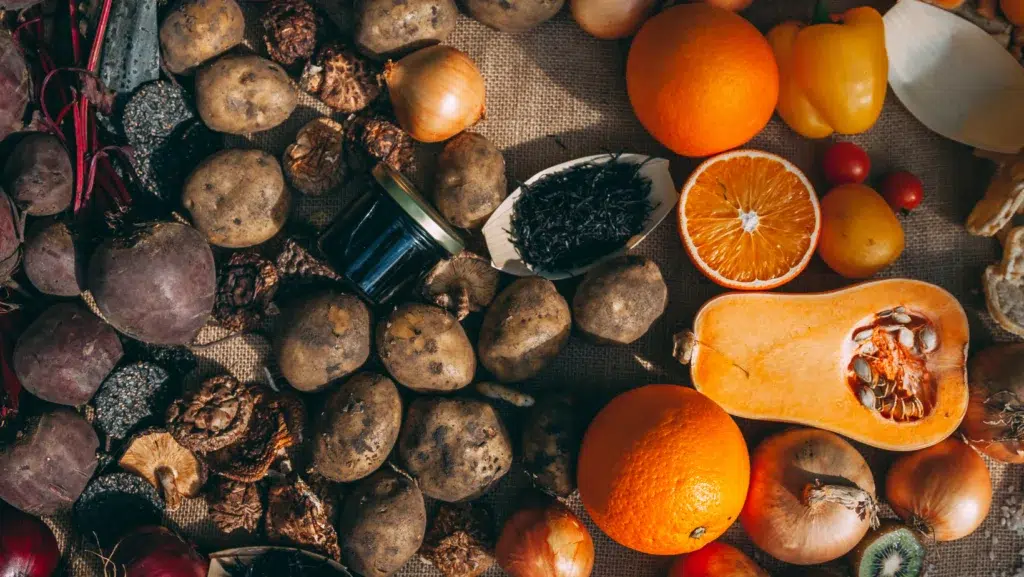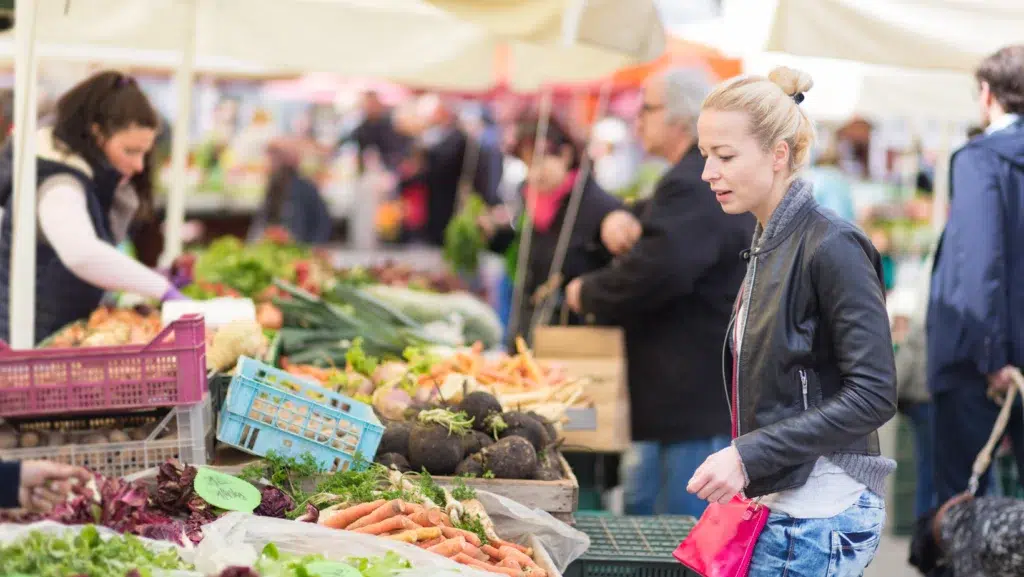Some links on this page are affiliate links. This means we may earn a commission at no additional cost to you if you click through and make a purchase, you can check our Affiliate Disclosure. Thank you for your support!
Jump into the vibrant world of seasonal ingredients, where every fruit and veggie shines at its brightest! Eating with the seasons isn’t just a trend; it’s a way to supercharge your meals with flavor, freshness, and a lot of love for the planet.
Understanding the Power of Seasonal Eating
Seasonal eating is all about harmony with nature’s calendar. It’s picking an apple straight from the tree in autumn or biting into a juicy watermelon during the summer heat. It’s simple: when you eat foods grown at the right time, they taste better, are packed with nutrients, and even cost less. It’s nature’s way of giving us exactly what we need, exactly when we need it.
Here’s how you can get started:
- Check out local produce calendars. They’ll tell you what’s in season every month.
- Visit your community farmer’s market. The folks there love to chat about their fresh picks!
- Try something new. If you see a fruit or vegetable you haven’t tried before, give it a go!

The Top Benefits of Using Seasonal Ingredients in Your Diet
Let’s break down why seasonal ingredients can be such game-changers:
- Flavor at its peak: Seasonal produce is fresh, which means it’s got the best taste.
- Nutritional jackpot: These ingredients often have more nutrients because they haven’t been stored long.
- Friendlier on the wallet: Seasonal food is usually cheaper because there’s plenty of it around.
- Eco-hero status: Eating seasonal means less transportation equals less carbon footprint. 🌍
- Support local farmers: Buying seasonal supports the local economy and your neighborhood growers.
You’re moving toward a healthier, more sustainable lifestyle by incorporating seasonal products into your dishes. We assure you that your palate will appreciate it! Let’s celebrate the best of the season at every meal.
Spring Forward with Freshness
Spring is when the world feels like it’s hitting the refresh button. And what better way to celebrate than with fresh seasonal ingredients that add a pop of flavor and nutrition to your meals?
A Guide to Identifying Spring’s Seasonal Ingredients
Spotting what’s best in spring is easy when you know what to look for:
- Greens make the scene: Watch for tender leafy greens like spinach, arugula, and Swiss chard.
- Berry good: Strawberries start to make their sweet entrance, so get ready for the first taste of what summer will bring.
- Pod squad: Look for peas and green beans that are firm and snappy – that’s when you know they’re ready to eat.
When you fill your basket with these spring stars, you’re not just prepping for delicious meals but also supporting your body with a boost of springtime goodness. 🌷🥗
Tips for Storing and Preserving Spring Produce
Got more spring produce than you can eat in a week? No sweat. Here’s how to keep it fresh:
- Cool as a cucumber: Store your leafy greens in the fridge, wrapped in a wet cloth to preserve them crisp.
- Berry careful: Strawberries should stay in their original container in the fridge—wait to wash them until you’re ready to eat.
- Peas in a pod: Fresh peas can be shelled and frozen, so you can enjoy their springtime flavor even when out of season.
ALSO READ: Amplify Your Kitchen’s Appeal with an Organized Pantry
Recall that using seasonal foods ensures the greatest possible results regarding taste, health benefits, and environmental friendliness. So let’s make the most of spring’s bountiful harvest!
Summer’s Seasonal Selections
Summer is like a bright, sunny day for your taste buds. It’s the season where the most colorful and juicy seasonal ingredients come out to play, making every meal a vibrant festival on your plate.
The Ultimate List of Summer Ingredients for Vibrant Meals
When the heat is on, these summer superstars are ready to turn up the flavor:
- Tomatoes: Ripe and bursting with juice, they’re summer’s all-stars.
- Berries: strawberries, blueberries, raspberries—they’re like little bursts of sunshine.
- Corn: Sweet and buttery, fresh off the cob is the way to go.
- Melons: Watermelon, cantaloupe, and honeydew bring the cool to those hot days.
- Stone fruits: Peaches, nectarines, and plums – oh my! Perfect for that sweet snack.
Get these seasonal ingredients onto your menu, and you’re all set for a summer of delicious eats. 🌞🍅
How to Maximize Flavor with Summer’s Fresh Picks
Summer produce is all about big flavors, and here’s how you can make the most of them:
- Keep it raw: Sometimes, the best way to enjoy summer produce is in its natural state. Think fresh salads or chilled fruit soups.
- Grill and chill: Get those grill marks on! Peaches, corn, and even watermelon can be transformed with smoke and char.
- Simple seasonings: Squeeze a lemon, add a dash of olive oil, or simply a sprinkle of salt to let the tastes take center stage.
Summer’s seasonal ingredients are guaranteed to add some pizzazz to your meals. They’re fresh, they’re flavorful, and they love the summer sun just as much as you do. So let’s get cooking and make this summer one for the flavor books!
Embracing Autumn’s Harvest
Autumn is the artist of the year, painting our markets with a palette of deep oranges, rich reds, and golden yellows. It’s the time to embrace the hearty, comforting seasonal ingredients that make your meals not just food, but an experience.
Finding and Choosing the Best Fall Seasonal Ingredients
When the leaves start to fall, it’s your cue to pick these autumn favorites:
- Pumpkins and squash: Look for ones that feel heavy for their size—they’re the keepers.
- Apples: Go for the ones with firm skin and that satisfying crunch when you bite into them.
- Root vegetables: Carrots, turnips, and beets should be firm and deep in color.
- Leafy greens: Kale and spinach thrive in cooler weather, so they’re super fresh in the fall.
- Herbs: Rosemary, thyme, and sage are autumn’s go-to flavors for a reason. They add depth to any dish!
Stack your basket with these seasonal goodies, and you’re halfway to the perfect fall feast. 🍂🍁
Strategies for Incorporating Autumn’s Richness into Your Meals
Autumn’s ingredients aren’t just for show; they’re full of flavors that deserve a spotlight in your cooking. Here’s how to bring out the best in them:
- Roasting is your friend: It brings out the natural sweetness in root veggies and squash.
- Stews and soups: They’re classic for a reason. Let autumn’s produce simmer and meld together in a pot of goodness.
- Baking and sautéing: Apples and pears caramelize beautifully when cooked, making for delicious desserts or savory sides.
By focusing on the textures and flavors of fall’s seasonal ingredients, you turn every meal into a celebration of the season. So let’s get cozy, get cooking, and enjoy the harvest!
Winter’s Nutrient-Rich Offerings
When winter rolls in with its frosty touch, it’s not just about snowflakes and cozy blankets — it’s also about enjoying the hearty and nutritious seasonal ingredients that this cool season brings.
Guide to Winter Produce That Packs a Flavorful Punch
Don’t let the cold weather fool you; winter’s produce can really turn up the heat in the flavor department. Here’s what to grab:
- Citrus fruits: Oranges, grapefruits, and lemons are at their zesty best.
- Root vegetables: Turn to turnips, parsnips, and sweet potatoes for earthy goodness.
- Winter greens: Kale and collards are sturdy enough to withstand the chill.
- Pomegranates and cranberries: These jewels add a pop of color and a tart kick.
These ingredients aren’t just surviving the cold; they’re thriving, and they’ll bring that energy right to your plate. 🍊❄️
Keeping Warm with Winter’s Seasonal Ingredients
Winter veggies and fruits are like a natural hug — they keep you warm and satisfied. Here’s how to make the most of them:
- Slow cooking: Those root veggies love to take their time in a slow cooker, getting all tender and flavorful.
- Roasting: Turn on the oven and let the natural sugars in carrots and squash caramelize to perfection.
- Citrus zing: Use the bright flavors of citrus to cut through the richness of winter dishes.
Embrace these seasonal ingredients, and you’ll find that winter meals can be just as exciting and flavor-packed as any summer barbecue. So, let’s get cooking and fill our kitchens with the warming aromas of winter!
Shopping Smart for Seasonal Ingredients
Knowing how to shop smart for seasonal ingredients is like having a secret weapon for your cooking. It’s all about getting the freshest, tastiest, and most nutritious bang for your buck – and it’s easier than you might think.
Where to Find the Best Seasonal Ingredients Near You
To get the freshest seasonal ingredients:
- Hit up local farmers’ markets: They’re the gold mines for the freshest produce.
- Join a CSA (Community Supported Agriculture): Get seasonal goodies delivered from the farm to your doorstep.
- Check out local food co-ops: They often stock produce that’s in season.
- Use seasonal food apps: They can point you to the best in-season food in your area.
By shopping locally, you’re getting the best flavors and supporting your local economy. Plus, you’ll know exactly where your food is coming from. 🍎🥕
Making the Most of Your Local Farmer’s Market
When you visit the farmer’s market, keep these tips in mind to get the most out of your trip:
- Go early or late: Early birds get the best selection, while latecomers might score some deals as vendors pack up.
- Ask questions: Farmers have a wealth of knowledge about their produce. They can tell you how it was grown and the best cooking methods.
- Be adventurous: Try one new seasonal ingredient each visit. It’s a great way to expand your palate.
- Bring cash and bags: Many vendors prefer cash, and bringing your bags is better for the environment.
Your local farmer’s market is more than just a place to buy food; it’s a community hub where you can learn, explore, and connect with the people who grow your food. So grab a tote and get ready to discover the joys of seasonal shopping!
Seasonal Ingredients for Optimal Health
Let’s talk about fueling up the right way. Seasonal ingredients aren’t just about amazing flavors; they’re also about packing your diet with the best nutrients out there. It’s like nature’s got your back, offering exactly what you need for a health boost at the right time.
The Nutritional Advantages of Eating with the Seasons
Here’s why you should sync your grocery list with the seasons:
- Freshness equals nutrients: Seasonal produce is picked at its peak. It hasn’t hung around in storage, so it’s bursting with vitamins.
- Support your body’s needs: Nature’s clever – it gives us citrus in winter when we need vitamin C and water-heavy fruits in summer to keep us hydrated.
- More bang for your buck: In-season produce can be less expensive, which means healthier food.
Eating seasonally is like giving your body a tune-up with every meal. You’re getting the best stuff, exactly when you need it. 🍇🥦
Seasonal Superfoods You Shouldn’t Miss
Every season has its heroes. Here are some superfoods to look out for throughout the year:
- Spring: Asparagus and strawberries come into play, bringing fiber and antioxidants.
- Summer: Berries and tomatoes are all the rage with their vitamins and lycopene.
- Fall: Squash and apples steal the show, rich in beta-carotene and fiber.
- Winter: Leafy greens like kale and citrus fruits are the stars, packed with vitamins A and C.
These superfoods are nature’s gift; make sure you enjoy the bounty! And remember, what grows together goes together, so these ingredients also work beautifully in combination. So, let’s eat up and enjoy the health benefits of every season!
Sustainability and Seasonal Ingredients
Going green with your food choices is way easier than you might think. It’s all about embracing those seasonal ingredients that don’t just taste better but also do better for the planet. Let’s dig into how a simple choice at the grocery store can be a big step for sustainability.
How Seasonal Ingredients Can Reduce Your Carbon Footprint
Every time you opt for seasonal ingredients, you make a choice that echoes positively worldwide. Here’s the lowdown:
- Travel tales: Seasonal produce often travels shorter distances to get to you, which means less fuel and lower emissions.
- Energy savings: Growing what’s meant to thrive in the current climate requires less artificial heating or cooling, slashing energy use.
- Less waste: Seasonal foods are eaten closer to when harvested, so they’re less likely to go bad on your plate.
By choosing seasonal, you’re not just eating, you’re casting a vote for the world you want to live in. 🌎♻️
The Role of Seasonal Ingredients in Sustainable Agriculture
Sustainable agriculture is all about growing food in a way that can keep on going for generations to come. Seasonal ingredients are superstars here:
- Supporting soil health: Crop rotation with seasonal plants helps keep the earth under them rich and ready to grow more.
- Encouraging biodiversity: Seasonal crops contribute to diverse habitats for wildlife, from bees to birds and beyond.
- Boosting local economies: When you buy seasonal, often you’re buying local. This means supporting smaller, sustainable farms in your community.
So, when picking out that bunch of carrots or that basket of apples, remember that they’re more than just a tasty snack. They’re part of a bigger picture that helps keep our meals and planet strong. Let’s make it a habit to choose seasonal!
Enhancing Your Cooking with Seasonal Ingredients
Cooking with seasonal ingredients is like tuning into nature’s rhythm and making your kitchen dance to its beats. It’s about taking the freshest, most flavorful produce and letting it shine in your meals.
Creative Ways to Use Seasonal Produce in Everyday Meals
Getting creative in the kitchen is a breeze with these tips:
- Swap them in: Take your go-to recipes and switch in seasonal veggies or fruits. Your taste buds will thank you!
- Dress them up: A dash of herbs or a sprinkle of spices can elevate a simple seasonal dish to something extraordinary.
- Mix and match: Try combining different seasonal produce in one dish. Sometimes, the most unexpected pairings make the best matches.
Remember, seasonal produce is the show’s star, so let it take the spotlight in your meals! 🍲🥗
Pairing Seasonal Ingredients for the Best Flavor Combinations
To get the most out of your seasonal ingredients, consider these pairings:
- Spring: Asparagus and lemon, strawberries and mint bring out the best in each other.
- Summer: Basil and tomato, peaches and cream – these are sunshine flavors.
- Fall: Squash and sage, apples and cinnamon – they’re like a warm hug on a chilly day.
- Winter: Roasted root vegetables and rosemary, citrus and fennel – these combos will brighten the darkest days.
By pairing seasonal ingredients, you’re not just cooking; you’re creating flavor symphonies that are as fresh as they are delicious. So, grab those seasonal picks and start experimenting – your next culinary masterpiece is just a pairing away!
Conclusion: The Art of Seasonal Ingredients
Wrapping up our journey with seasonal ingredients, it’s clear they’re not just a choice but an art form. It’s about celebrating the rhythms of nature, bringing its diversity onto our plates and into our lives in the most delicious way.
Celebrating the Rhythms of Nature Through Your Diet
Here’s how you can get in tune with nature’s tempo:
- Go with the flow: Embrace each season’s offerings. Let the natural cycle guide your menu planning.
- Connect with the source: Understand where and how your food grows. It can deepen your appreciation for each bite.
- Seasonal traditions: Create your family food traditions based around seasonal changes.
Living in harmony with the seasons isn’t just a dietary choice; it’s a lifestyle. And with each season, you get a whole new set of flavors to explore and enjoy. 🌷☀️🍂❄️
ALSO READ: Unlock the Delights of Cheeses: A Gourmet’s Guide to the Finest Varieties
How Embracing Seasonal Ingredients Can Transform Your Cooking
Using seasonal ingredients does wonders for your cooking:
- Boosts flavor: Fresh, in-season produce is naturally more flavorful.
- Inspires creativity: Each season brings new produce to play with, challenging you to try new dishes.
- Builds community: Sharing seasonal dishes can bring friends and family together in a shared appreciation for good food.
By letting seasonal ingredients lead the way, you turn each meal into a celebration of the here and now. So, let’s cook with the seasons, not against them, and watch how our meals – and lives – bloom with flavor.
ALSO READ: Elevate Your Baking Game by Discovering Flour Varieties
Common Questions
What ingredients are seasonal?
Seasonal ingredients are currently being harvested and are at their peak in flavor or abundance during a particular time of year. For example, strawberries are typically seasonal in late spring and early summer, while apples are in the fall.
What foods are in what seasons?
- Spring: Asparagus, strawberries, peas, radishes, rhubarb.
- Summer: Tomatoes, corn, melons, berries, cucumbers, peaches.
- Fall: Apples, squash, pumpkins, pears, sweet potatoes, figs.
- Winter: Citrus fruits, kale, leeks, turnips, winter squash, pomegranates.
Why should we use seasonal ingredients?
Using seasonal ingredients means your food is fresher and tastier. They’re often more nutritious and environmentally friendly due to reduced transportation and storage. Plus, they can be more cost-effective and support local economies.
Why are some foods seasonal?
Foods are seasonal mainly due to the natural growing cycles dictated by weather patterns, temperatures, and daylight hours. Some plants thrive in the warm summer, while others prefer cooler, shorter days. Agriculture and global transport advances have made many foods available year-round, but they are traditionally tied to specific seasons.

